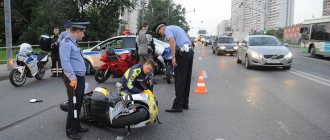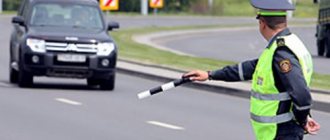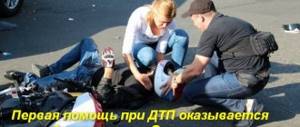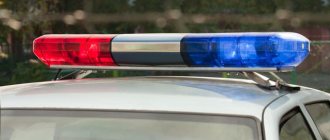A collision with another car or a traffic accident caused by other circumstances is not a pleasant incident for any driver. Loss of time, and often money, difficult communication with another participant in the accident, calling the police - all this has to be faced by those who are involved in an accident. But if you are sure that you followed the traffic rules and are not to blame for the accident, it is better to calm down and wait for a fair decision from the traffic police and the insurance company, which must compensate for the damage.
In some cases, the culprit of an accident can be determined without difficulty; often one of the participants in the accident himself admits his guilt: such an obvious violation of the rules was committed. In this case, the parties either draw up a “European protocol” on their own (it is important to draw the diagram of the accident correctly), or call the traffic police crew to document the incident.
If immediately after the collision you cannot control yourself, we recommend that you do not give any confession at all on the spot. We recommend that you formulate your position in the analysis group’s office, in a neutral environment, after first recalling in detail all the circumstances of the accident.
If a police officer arriving at the scene of an accident is unsure which of the participants initiated the collision, he creates an Incident Report, in which he records his thoughts regarding the potential culprit of the accident, and then transfers this paper to the regional traffic police department. Also, the case can be transferred to the authorities for additional investigation if the alleged culprit categorically disagrees with the alleged violation. Thus, if you are asked to take the blame, and you are sure that you followed all the rules of the road accident, immediately tell the police officer that you do not agree with his verdict. Then the proceedings will be transferred from the roadway to the internal affairs bodies.
Never put your signature on blank explanation sheets or on an unfilled road accident diagram. Do not break this rule, even when the traffic police inspector says that he urgently needs to leave.
After drawing up the protocol, the participants in the accident on the spot receive instructions encouraging them to appear at a certain time for the analysis of the accident at the traffic police.
When is it necessary to review a traffic accident at the State Traffic Inspectorate?
Participants in the accident must first comply with the requirements of clause 2.6. 2 traffic regulations. According to this paragraph, the person is obliged to provide first aid to the victims, and, if possible, send them to the nearest medical facility using passing transport (take them independently). You also need to call the State Traffic Inspectorate and wait for their arrival.
Attention! If you have any questions, you can chat for free with a lawyer at the bottom of the screen or call Moscow; Saint Petersburg; Free call for all of Russia.
If the accident is not significant and cars can move, it is necessary to clear the roadway (if it is blocked). Before you start driving, you should consult with a traffic police officer using the number of the duty station, then record the position of the vehicle in relation to the other participant’s car and the surrounding situation, including details directly related to the incident.
If the damage was caused only to transport (in the amount of up to 100 thousand rubles), 2 cars were involved in the accident, each driver has a valid MTPL policy and the culprit admits his mistake, then photo and video recording of the scene of the incident is allowed with the subsequent registration of a European protocol without the involvement Traffic police (Article 11.1 of Federal Law No. 40-FZ).
If there are disagreements or failure to comply with the conditions outlined in the previous paragraph, you must notify the State Traffic Inspectorate. Employees who arrived at the accident carry out an analysis of the accident in accordance with clause 269 of section III of Order of the Ministry of Internal Affairs of the Russian Federation No. 664. Authorized persons fencing the accident site, identifying the participants in the incident and their vehicles, searching and interviewing eyewitnesses, recording personal data, and inspecting the road situation. The main act is the protocol on the offense and the road accident diagram.
If the reasons for the incident are obvious, and the parties do not disagree in their testimony, then the inspector issues a fine to the traffic violation violator. All parties (mutually) can be found guilty. At the same time, it is worth separating civil liability arising in connection with damage to the victim and non-compliance with traffic rules. Collection of funds for traffic violations is made to the budget. The full list of sanctions can be found in Chapter. 12 Code of Administrative Offenses of the Russian Federation. In some cases, when analyzing an accident, no penalties are applied to the culprit. This applies to clause 10.1 (hitting an obstacle), clause 8.1 (use of turn signals) of the Russian Traffic Regulations. In the first case, there is a presumption of innocence (if the driver moved taking into account the traffic situation), and in the second, the inspector will most likely not be able to prove the fact that the signals were turned on. Among other things, a violation for which there is no fine will not entail liability (for example, speeding up to 20 km/h). The same applies to the influence of force majeure circumstances on the vehicle (hurricane wind, lightning strike, etc.).
There are cases in which it is not possible to reliably determine the circumstances. Then the accident report is sent to the traffic police analysis group. The text of the document indicates the alleged violator. Participants receive an order to attend the administrative practice group (APG) at the State Traffic Inspectorate unit. The document indicates the exact time and day on which the traffic accident is scheduled to be analyzed by the traffic police.
The internal department is authorized to investigate the incident and make a final decision.
How accidents are investigated in various organizations
According to regulatory documents, an official investigation of an accident at an enterprise must be organized without fail, regardless of whether it is state-owned or privately owned. This requirement also applies to private entrepreneurs conducting business without organizing a legal entity. This requirement is contained in the Road Safety Law No. 196-FZ.
The regulation on the order in which such investigations are carried out at a particular enterprise is an internal document that must be developed and approved accordingly by the enterprise. The document identifies the persons responsible for the investigations. In the process of carrying out the established activities, these persons must interact with the traffic police authorities conducting the inquiry and investigation.
For each incident in an organization, an order is issued to create a commission to conduct an internal investigation. The results of the investigation are reflected in the report. The period for conducting internal official investigations is 5 days. Each case of an accident with the cars of organizations must be entered into the accident registration log, which is maintained without fail.
Who conducts accident investigations?
GAP (administrative practice group) is a special education located in the district division of the State Traffic Inspectorate. The structure is engaged in high-quality detailed research of road accidents. The tasks of the traffic police group are to carry out a complete analysis of the accident:
- an objective analysis of all the circumstances leading to the accident;
- establishing the causes of the incident;
- determining the guilt of a person.
The result of the analysis of an accident in the traffic police is a clear classification of the violation that led to the accident and its correlation with the rules of the road. The final act is a resolution on the application of penalties to those responsible for a traffic accident.
Debriefing group - what is it?
The analysis group in the traffic police department is a specially convened group responsible for practice on administrative issues. It consists of competent inspectors who know all the subtleties and nuances of the administrative code. The analysis group is located in the central division of the State Traffic Inspectorate.
Her area of responsibility includes a detailed analysis of all the details of an accident that occurred on the road. They must conduct an objective assessment of the accident, identifying the causes and degree of guilt of all participants in the emergency.
Inspectors, relying on their experience and knowledge of the law, can skillfully explain the accident, specifying which rules were violated and clearly defining the optimal punishment for each of them.
Based on the results of the work of the analysis group, an appropriate resolution on the offense that occurred is drawn up. The appointment to conduct an analysis of emergency situations on the highway and road is carried out after the accident has occurred and a package of documents relating to the incident has been completed. It is issued by an inspector who arrives at the scene of the incident to investigate the situation.
Is it possible not to attend such a meeting? In theory, yes, if there is clear confidence that the person to blame for what happened has been identified. This should already be written down in the appropriate protocol. However, not all accidents are obvious at first glance.
If you have even the slightest doubt, it’s worth spending a day but taking part in the analysis. If necessary, this is the only way to prove that you are right.
What happens during an accident investigation at the traffic police?
If it is necessary to take additional measures, the traffic police officer invites drivers to the inspection located at the place of the accident. If this was not done immediately when registering an accident, then persons are notified by mail. The incident materials themselves are also sent to the department.
After receiving a report drawn up at the scene of an accident, a group of inspectors gathers and is required to analyze the accident, review the documentation and listen to citizens to make a decision on imposing a fine.
Analysis of an accident in the traffic police involves several mandatory stages, the implementation of which depends on the circumstances of a particular case. The main points that every driver should be aware of are:
- The analysis of the accident in the traffic police is preceded by the analysis of materials obtained at the scene of the incident, as well as as a result of interviewing witnesses. The object of action is the fact of an accident recorded by the State Traffic Inspectorate. These manipulations take from three days to a month.
- Often, to establish details, traceological and automotive technical examinations are required. If authorized traffic police officers do not dare to take such a step, explaining what is happening with a high workload, then the interested person himself must insist on carrying out the indicated investigations of the accident.
- During the investigation of the accident, the traffic police are clarifying the details of the incident. Drivers are interviewed and official documents are studied. Parties are invited at once or separately. The first can be considered a confrontation. The indicated approach allows us to identify the fact of giving false testimony.
- During the investigation of the accident, inspectors do not allow the parties to familiarize themselves with the documentation on the case. This includes the diagram of a traffic accident. This encourages drivers to remember the details themselves and increases the objectivity of the measures being implemented.
Upon completion of the analysis of the accident, the traffic police officers make a decision, approved in the form of a protocol.
What to do before analysis
Since the review process can be lengthy, it is important to know what to do while preparing for the review.
- Take care of the appearance of witnesses whose information was announced when drawing up documents at the scene of the accident.
- Get legal advice regarding the situation, and if possible, invite it to the traffic police for consideration.
- Study the accident report, familiarize yourself with all the points of the traffic rules that are mentioned. It is important to compare this data with the real situation - traffic police officers may make a mistake in the paragraph of the rules that were violated.
- If attendance at the hearing is not possible, you must ask to reschedule the time or place of the hearing. This should be done in advance, otherwise the review will occur, and the consequences may not be the best.
Rights of participants in an accident during accident investigation
When analyzing an accident in the traffic police, traffic police officers cannot prevent the victim/culprit from carrying out the following actions:
- Use the services of an experienced lawyer (Clause 1, Article 25.1 of the Code of Administrative Offenses of the Russian Federation). It is usually required when there is a mutual violation or there are victims. It is recommended to seek the help of a lawyer at the initial stage. Thus, the defendant will have a competent line of behavior.
- Familiarize yourself with the documentation of the case before analyzing the accident. According to Art. 25.1 of the Code of Administrative Offenses of the Russian Federation, a person has the right to find out in advance about the papers that are present in his case. For this purpose, the citizen will need to appear at the inspection before the SAPD group begins the final actions.
- Submit a petition, submit explanatory notes, supplement the case with other acts. If a citizen took photos or videos at the scene of the incident, then he has the right to demand that the materials be included in the case. It is important to keep in mind that Article 51 of the Constitution of the Russian Federation allows a person not to testify against himself and his loved ones.
- Ask for an examination.
- Request certificates from authorized bodies about the condition of road lighting and pavement.
- Foreign nationals may involve an interpreter in the process.
- Protest the decision of the traffic accident investigation in the traffic police.
Rules of conduct for road accident participants
Participation in the analysis is useful not only for the obvious culprit, but also for each participant in the accident. No one knows you better and can defend your interests. If something prevents you from visiting the traffic police on the day when the analysis takes place, it is possible to apply to reschedule the date.
Before showing up at the appointed time, it is recommended to think over your position. Recover in your memory not only the accident itself, but also everything that was said to the traffic police inspector at the scene of the incident. Inconsistencies in the testimony of the same person arouse suspicion among police officers. In addition, it is better to know which regulations you can rely on when protecting your rights.
You can and should use any photographs and videos that confirm your position. The same applies to witnesses who can testify in your favor. Also, do not forget that the Constitution allows you not to testify against the interests of yourself and your relatives.
Sometimes you may get the impression that the inspector is “pressuring” you because he is more inclined to favor the other side’s version. Even if time does not confirm your suspicions, audio recording of your communication will help you both protect and reassure yourself. In the worst case, these records need to be attached to the complaint to the head of the territorial traffic police department or the prosecutor. Of course, the statement must be supported by significant evidence.
The final decision of the analysis team is issued to the person responsible for the accident. When the latter does not agree with the conclusions, he has the right to appeal them within 10 days. The examination by the state traffic inspectorate only determines who is right and who is wrong. The final word, including in establishing a preventive measure, rests with the court.
How to behave during the analysis of an accident at the State Traffic Inspectorate?
When visiting the traffic police, you need to replay in your head everything that happened on the day of the incident. This is required to ensure that the submitted explanations correspond to those recorded previously. Discovered discrepancies are a good reason for employees included in the State Traffic Safety Inspectorate to agree with the opponent’s position in the analysis of an accident.
In a confrontation, it may turn out that the employee has accepted the version of one of the parties to the conflict and is trying to put pressure on the other. Then you need to record the conversation on a voice recorder. Subsequently, the recording can be sent to the prosecutor’s office or to the department’s management. The complaint will only be considered if the evidence submitted with the application is compelling.
Often, controversial situations are resolved objectively and without the involvement of technical analysts. The inspectors themselves, when analyzing road accidents, try to do without examinations, since their results may not coincide with the preliminary conclusions. In addition, the services of the Ministry of Internal Affairs of the Russian Federation are heavily loaded, which requires the involvement of third-party companies. Their actions come at a high price tag.
What should the culprit do in case of an accident?
When an accident occurs, it is important for the culprit not to panic and not to leave the scene of the accident in order to try to avoid liability - this will not work anyway. Nowadays, with the development of technology, finding a driver by car number is not difficult. Therefore, it is extremely important to know how to act after an accident under compulsory motor liability insurance if you yourself are to blame for creating an emergency situation.
- Call the traffic police. If the accident is minor and there are no disagreements between the participants, it is possible to reach an agreement without involving third parties and draw up a Europrotocol. If not only the car, but also another person was injured, first of all you need to call an ambulance.
- You cannot move the vehicle to another location or move its parts. Emergency signs must be posted on roads. However, if there are no casualties or critical damage to the vehicles, the vehicle must be removed from the roadway after recording all the details on the accident diagram.
- It is necessary to take video or photograph of the scene of the incident - this is done in the presence of the victim. The video recording or photographs should show the position of the vehicles after the collision, their damage and other details characterizing the accident. The victim’s car is carefully inspected, all damage is necessarily photographed in order to avoid further disagreements regarding compensation for damage.
- It is necessary to record the personal and contact information of all participants in the accident and witnesses.
- Insurance information should be exchanged with the victim. Contacts of insurance companies are transmitted; if there is a CASCO policy, its number is also recorded.
- It is necessary to issue a notification of an accident; all participants in the incident must sign it.
- You need to find out when a decision on an accident will be made; if this is done by a police officer on the spot, read it carefully. When the culprit does not agree with some facts when registering an accident, he makes an entry about this in the protocol, after which he can challenge the conclusion of the accident within 10 days.
- At the end of the procedure, obtain and check the correctness of the documents regarding the accident: a certificate of the accident, a protocol and a resolution on an administrative offense.
- Notify your insurer.
According to Article 11, 11.1 of the law on compulsory motor liability insurance, when drawing up the Europrotocol, both parties need to send their copy of the document to the insurance company. Duration – 5 days. Then the insurers must receive a request to send the vehicles for inspection (this is given 5 days from the date of receipt of the letter).











